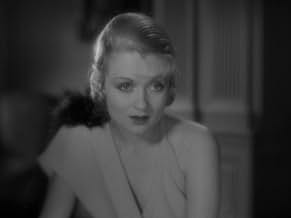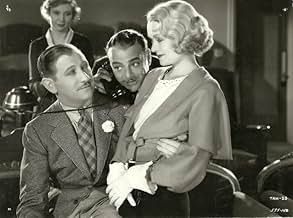VALUTAZIONE IMDb
7,0/10
2762
LA TUA VALUTAZIONE
La carriera di una cameriera sembra prendere il via quando incontra un'amabile e ubriacone regista di Hollywood.La carriera di una cameriera sembra prendere il via quando incontra un'amabile e ubriacone regista di Hollywood.La carriera di una cameriera sembra prendere il via quando incontra un'amabile e ubriacone regista di Hollywood.
- Candidato a 1 Oscar
- 1 candidatura in totale
George Reed
- Undetermined Secondary Role
- (scene tagliate)
Alice Adair
- Undetermined Secondary Role
- (non citato nei titoli originali)
Eddie 'Rochester' Anderson
- James - Max's Butler
- (non citato nei titoli originali)
Sam Armstrong
- Undetermined Secondary Role
- (non citato nei titoli originali)
Zeena Baer
- Secretary to Julius Saxe
- (non citato nei titoli originali)
King Baggot
- Department Head
- (non citato nei titoli originali)
Gerald Barry
- John Reed - an Actor
- (non citato nei titoli originali)
Floyd Bell
- Undetermined Secondary Role
- (non citato nei titoli originali)
Veda Buckland
- Nana - Jackie's Nursemaid
- (non citato nei titoli originali)
Nicholas Caruso
- Chef at Brown Derby
- (non citato nei titoli originali)
Lita Chevret
- Actress Filming on Movie Set
- (non citato nei titoli originali)
Trama
Lo sapevi?
- QuizThis film bears such a striking resemblance to È nata una stella (1937) that it is often considered "the original version" of that often remade classic. In fact, David O. Selznick, who produced both this film and Star is Born, was threatened with a lawsuit by this film's writers, claiming plagiarism.
- BlooperWhen the screen shows a newspaper gossip column, we can see part of an item relating a joke about a Jewish boy and a bird. Several months later, another gossip column shows the identical item.
- Curiosità sui creditiThere is a "by" credit to Gene Fowler and Rowland Brown after the title shows, but there is also a "screenplay by" credit to Jane Murfin and Ben Markson, without leaving any clear explanation or context as to what "by" actually means. But the reality was that Fowler and Brown wrote the real screenplay, with Murfin and Markson providing the continuity.
- ConnessioniFeatured in David O. Selznick: 'Your New Producer' (1935)
- Colonne sonoreThree Little Words
(1930) (uncredited)
Music by Harry Ruby
Part of a medley played during the opening credits
Recensione in evidenza
It's fun to compare "What Price Hollywood," made in 1932, to the more familiar 1937 version of "A Star is Born" (as well as its two later remakes). An important historic event intervened between the two: the Hays Code became rigidly enforced in 1934. The 1932 version is much spicier. Mary, the unknown knockout in in the 1932 version, is a saucy waitress at the legendary Brown Derby restaurant trying to catch the eye of a movie big shot. She's pretty sophisticated and, you believe, would happily do whatever is required to land an acting job. She readily allows herself to be picked up and taken to a premiere by a famous (but fading) director, which launches her great career. In the 1937 version, Esther, the ingenue, is straight off the farm and comes to Hollywood without a clue about the movie biz. She's a goody-two-shoes who would be shocked about what it usually takes to break into the biz. She catches the eye of a famous (but fading and highly alcoholic) actor when she waitresses at a party.
There is one major plot difference: in the 1932 version, Mary marries a rich polo playing socialite who divorces her (while she's pregnant) because he is fed up with movie people. This is highly realistic--movie stars had terrible marital problems. In the 1937 version, Esther marries the actor who was her mentor and is sucked into his hopeless downward spiral. Divorce is a perfectly acceptable solution to marital problems in 1932 but, under the constraints of the Code, was out of the question in 1937.
Both films are well worth seeing. They're loaded with insights about Hollywood and filmmaking (both the creative and the business end), the rapacious movie press, and the fans--an insatiable monster that devours the object of its affection. The declining fortunes of the director (in "What Price Hollywood") and the actor (in "A Star is Born") are quite fascinating. But of the two--the 1932 version is a lot more fun.
There is one major plot difference: in the 1932 version, Mary marries a rich polo playing socialite who divorces her (while she's pregnant) because he is fed up with movie people. This is highly realistic--movie stars had terrible marital problems. In the 1937 version, Esther marries the actor who was her mentor and is sucked into his hopeless downward spiral. Divorce is a perfectly acceptable solution to marital problems in 1932 but, under the constraints of the Code, was out of the question in 1937.
Both films are well worth seeing. They're loaded with insights about Hollywood and filmmaking (both the creative and the business end), the rapacious movie press, and the fans--an insatiable monster that devours the object of its affection. The declining fortunes of the director (in "What Price Hollywood") and the actor (in "A Star is Born") are quite fascinating. But of the two--the 1932 version is a lot more fun.
- Michael-110
- 28 dic 1999
- Permalink
I più visti
Accedi per valutare e creare un elenco di titoli salvati per ottenere consigli personalizzati
- How long is What Price Hollywood??Powered by Alexa
Dettagli
- Data di uscita
- Paese di origine
- Lingue
- Celebre anche come
- What Price Hollywood?
- Luoghi delle riprese
- Azienda produttrice
- Vedi altri crediti dell’azienda su IMDbPro
Botteghino
- Budget
- 411.676 USD (previsto)
- Tempo di esecuzione1 ora 28 minuti
- Colore
- Proporzioni
- 1.37 : 1
Contribuisci a questa pagina
Suggerisci una modifica o aggiungi i contenuti mancanti

Divario superiore
By what name was A che prezzo Hollywood? (1932) officially released in India in English?
Rispondi





























